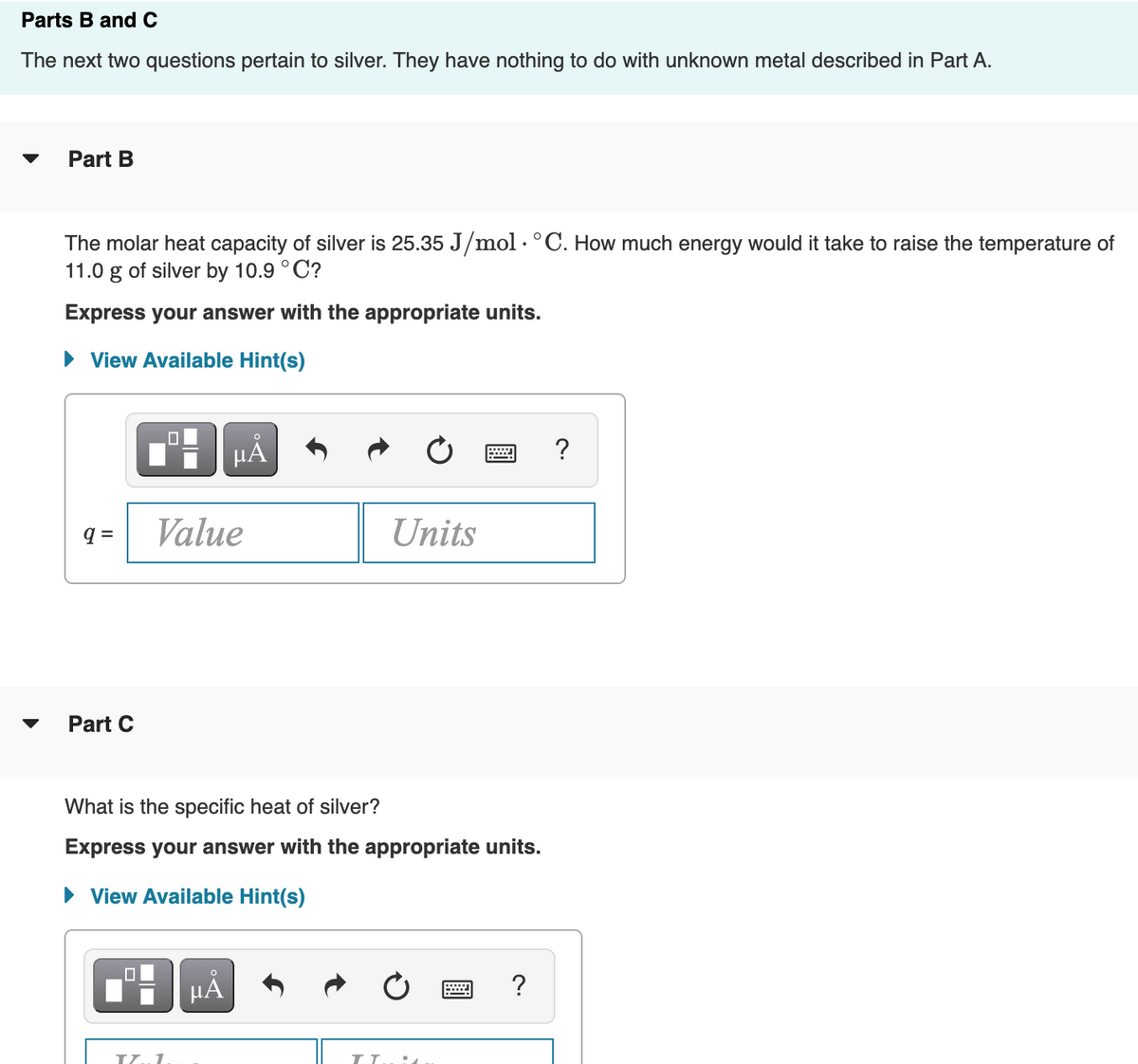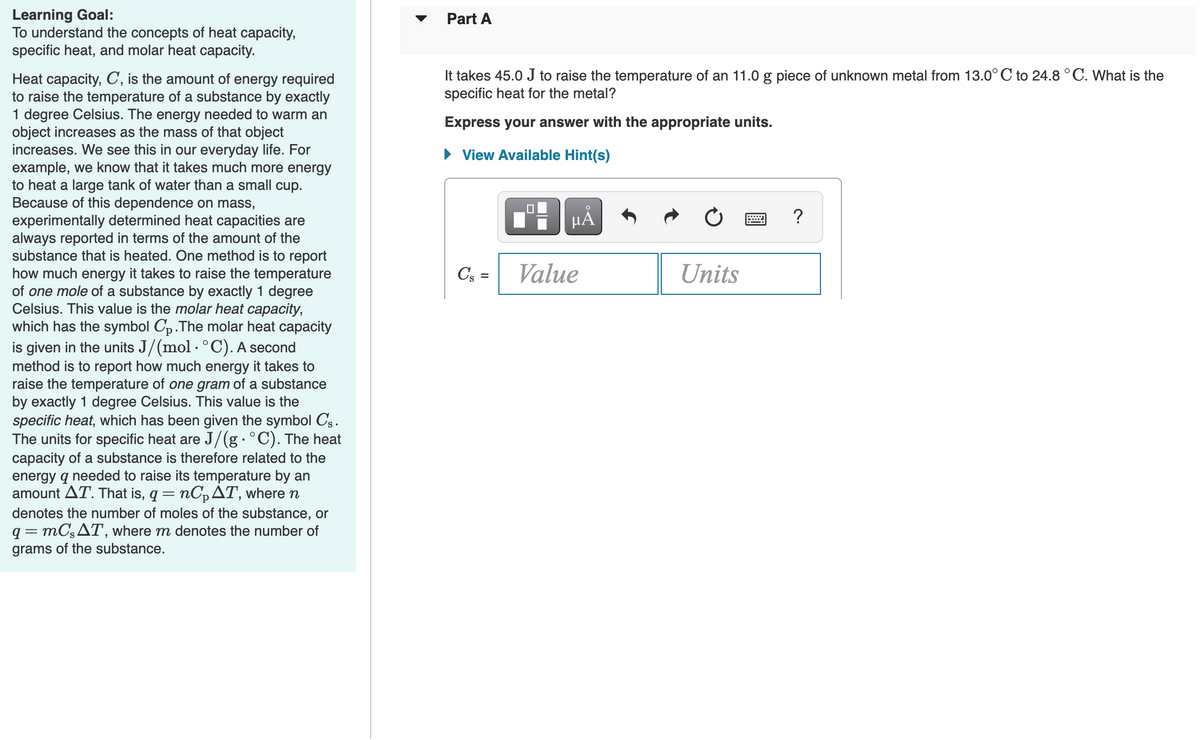art B he molar heat capacity of silver is 25.35 J/mol · °C. How much energy would it take to raise the temperature of 1.0 g of silver by 10.9 °C? xpress your answer with the appropriate units. View Available Hint(s) HA ? q = Value Units Part C /hat is the specific heat of silver? xpress your answer with the appropriate units. View Available Hint(s)
art B he molar heat capacity of silver is 25.35 J/mol · °C. How much energy would it take to raise the temperature of 1.0 g of silver by 10.9 °C? xpress your answer with the appropriate units. View Available Hint(s) HA ? q = Value Units Part C /hat is the specific heat of silver? xpress your answer with the appropriate units. View Available Hint(s)
Chemistry: The Molecular Science
5th Edition
ISBN:9781285199047
Author:John W. Moore, Conrad L. Stanitski
Publisher:John W. Moore, Conrad L. Stanitski
Chapter4: Energy And Chemical Reactions
Section: Chapter Questions
Problem 89QRT
Related questions
Question
100%
Please answer question 2 part A, B, and C

Transcribed Image Text:Parts B andC
The next two questions pertain to silver. They have nothing to do with unknown metal described in Part A.
Part B
The molar heat capacity of silver is 25.35 J/mol · °C. How much energy would it take to raise the temperature of
11.0 g of silver by 10.9 °C?
Express your answer with the appropriate units.
• View Available Hint(s)
HẢ
?
q =
Value
Units
Part C
What is the specific heat of silver?
Express your answer with the appropriate units.
• View Available Hint(s)
HA
?

Transcribed Image Text:Learning Goal:
To understand the concepts of heat capacity,
specific heat, and molar heat capacity.
Part A
It takes 45.0 J to raise the temperature of an 11.0 g piece of unknown metal from 13.0° C to 24.8 °C. What is the
specific heat for the metal?
Heat capacity, C, is the amount of energy required
to raise the temperature of a substance by exactly
1 degree Celsius. The energy needed to warm an
object increases as the mass of that object
increases. We see this in our everyday life. For
example, we know that it takes much more energy
to heat a large tank of water than a small cup.
Because of this dependence on mass,
experimentally determined heat capacities are
always reported in terms of the amount of the
ubst
Express your answer with the appropriate units.
• View Available Hint(s)
HẢ
?
ce that is heated. One method is to report
Value
Units
how much energy it takes to raise the temperature
of one mole of a substance by exactly 1 degree
Celsius. This value is the molar heat capacity,
which has the symbol Cp.The molar heat capacity
is given in the units J/(mol · °C). A second
method is to report how much energy it takes to
raise the temperature of one gram of a substance
by exactly 1 degree Celsius. This value is the
specific heat, which has been given the symbol Cs.
The units for specific heat are J/(g.°C). The heat
capacity of a substance is therefore related to the
energy q needed to raise its temperature by an
amount AT. That is, q = nCpAT, where n
Cs =
%3D
denotes the number of moles of the substance, or
MC5AT, where m denotes the number of
grams of the substance.
Expert Solution
This question has been solved!
Explore an expertly crafted, step-by-step solution for a thorough understanding of key concepts.
This is a popular solution!
Trending now
This is a popular solution!
Step by step
Solved in 4 steps with 5 images

Knowledge Booster
Learn more about
Need a deep-dive on the concept behind this application? Look no further. Learn more about this topic, chemistry and related others by exploring similar questions and additional content below.Recommended textbooks for you

Chemistry: The Molecular Science
Chemistry
ISBN:
9781285199047
Author:
John W. Moore, Conrad L. Stanitski
Publisher:
Cengage Learning

Chemistry & Chemical Reactivity
Chemistry
ISBN:
9781133949640
Author:
John C. Kotz, Paul M. Treichel, John Townsend, David Treichel
Publisher:
Cengage Learning

Chemistry & Chemical Reactivity
Chemistry
ISBN:
9781337399074
Author:
John C. Kotz, Paul M. Treichel, John Townsend, David Treichel
Publisher:
Cengage Learning

Chemistry: The Molecular Science
Chemistry
ISBN:
9781285199047
Author:
John W. Moore, Conrad L. Stanitski
Publisher:
Cengage Learning

Chemistry & Chemical Reactivity
Chemistry
ISBN:
9781133949640
Author:
John C. Kotz, Paul M. Treichel, John Townsend, David Treichel
Publisher:
Cengage Learning

Chemistry & Chemical Reactivity
Chemistry
ISBN:
9781337399074
Author:
John C. Kotz, Paul M. Treichel, John Townsend, David Treichel
Publisher:
Cengage Learning

Chemistry for Engineering Students
Chemistry
ISBN:
9781337398909
Author:
Lawrence S. Brown, Tom Holme
Publisher:
Cengage Learning

General Chemistry - Standalone book (MindTap Cour…
Chemistry
ISBN:
9781305580343
Author:
Steven D. Gammon, Ebbing, Darrell Ebbing, Steven D., Darrell; Gammon, Darrell Ebbing; Steven D. Gammon, Darrell D.; Gammon, Ebbing; Steven D. Gammon; Darrell
Publisher:
Cengage Learning

Chemistry by OpenStax (2015-05-04)
Chemistry
ISBN:
9781938168390
Author:
Klaus Theopold, Richard H Langley, Paul Flowers, William R. Robinson, Mark Blaser
Publisher:
OpenStax